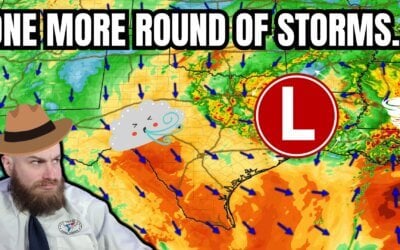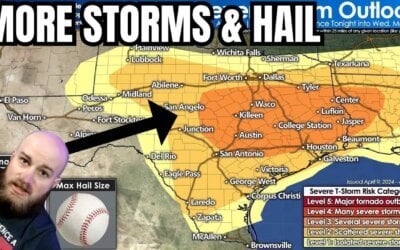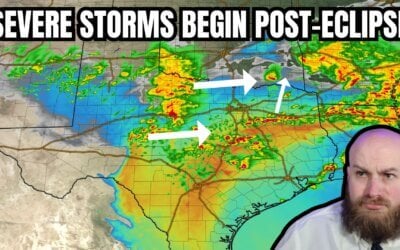Summer lovers…you have one more day to enjoy your heat and humidity before fall makes its first visit! Yes…we all know by now that cold fronts in Texas are really more like “kindof coolish fronts”, especially this time of the year. And yes…this front is expected to make it all the way south to the coast, but it will be somewhat modified by the time it gets there. Nevertheless, we will welcome it with open arms, fake fall leaves and dreams of sweaters and hot chocolate and socks with our flip flops. Temps will be cooler, but still warm, for a few days after the front arrives but the big difference will be the much drier air and lack of humidity that will last for at least another week or so. If nothing else, that will make being outside much more pleasant and enjoyable for all. Let’s talk about the timing of the front and break it down by regions of the state. Keep in mind, this is a pretty strong early season front, so it may actually move quicker than what most of our short range forecast guidance is allowing at this time. That said, the timeline below should give everyone a fair estimate of when to expect the front to arrive in their particular location.
Panhandle Region
If current forecast models stay on track, the front should enter the northern panhandle region by tomorrow morning likely after sunrise into mid-morning. It will continue a slow but steady pace south towards Lubbock before slowing down and waiting on a secondary push of upper level energy to shove it further south during the overnight hours. Folks in areas from about Amarillo northward tomorrow should see nice pleasant temperatures while the rest of us continue to bake like biscuits for one more day.
Rolling Plains, Northern Permian Basin, Western North Texas and North Central Texas
The front will drop into the rolling plains and through western north Texas during the overnight hours Monday night and will likely be draped southwest to northeast from around Midland/Odessa up to just west of the DFW metro area before sunrise on Tuesday. The front is expected to move through the DFW metro area between 6am to 9am or thereabouts. You’ll know when it arrives by virtue of its gusty north winds. Unfortunately, we won’t see much chance for rain with the front across much of north or north central Texas.
Central Texas and Northeast Texas
By around Noon on Tuesday, the front should be draped southwest to northeast from about Ft. Stockton to Junction and up through about Waco to Texarkana. A fairly sharp temperature gradient will develop with areas ahead of the cold front see temps rising into the low to mid 90s with temperatures behind the front dropping quickly down into the 80s to mid 70s. Showers and storms along the frontal boundary will be most likely during the mid to late afternoon time frame during peak daytime heating, but coverage will not be great. Any storms that develop are not expected to be severe but may carry the threat of downburst winds, cloud to ground lightning and brief heavy rainfall.
Southeast, South Central Texas and Deep South Texas
By Tuesday afternoon and early evening, the front should be through Austin/San Antonio and pushing into areas just north of Houston. The front should arrive along the southeast Texas coast and our coastal bend regions by around midnight Tuesday into Wednesday, then finally push into deep South Texas and through Brownsville by early Wednesday morning. Again, not much chance for meaningful rainfall or storms, but scattered showers along the frontal boundary are possible.
So what’s up with the unseasonably hot forecast highs for Monday ahead of the front? Compressional heating related to downsloping winds coming out of western Texas. It’s a phrase we hear quite often related to the arrival of fronts and tends to be most noticeable with the arrival of stronger cold fronts. The National Weather Service office in Ft. Worth has prepared a nice graphic below to explain why compressional heating can cause temperatures to soar immediately preceding the passage of a front. As southwest winds ahead of the front descend in elevation from west to east across the state, air molecules become compressed and heat up as they descend lower and lower in the atmosphere where air pressure is higher than it was back west at higher elevations. Basically the higher you ascend in the atmosphere, the lower the air pressure…and vice versa. The act of compressing the air (squeezing it into a smaller space) as it moves into areas with higher atmospheric pressure makes the air molecules vibrate more rapidly, which increases their temperature. There’s your fun science fact of the day!
Sadly, fronts this early in the season in Texas don’t stick around long. By next weekend, temps look to be climbing back to seasonal or just above seasonal averages once again with widespread upper 80s and low 90s for daytime highs; however, the drier and less humid air does look like it will stick around for at least the next week or so. This will feel great for getting out and about as your sweat will actually evaporate off your body rather than clinging to you like a wet dryer sheet, but it won’t be good for wildfire conditions out west where spring rains have left us with plenty of wildfire fuels. This will likely mean that folks out west will need to begin keeping an eye out for fire weather conditions by end of this week into next week with little to no rain in the 7-day forecast after the front passes.









0 Comments